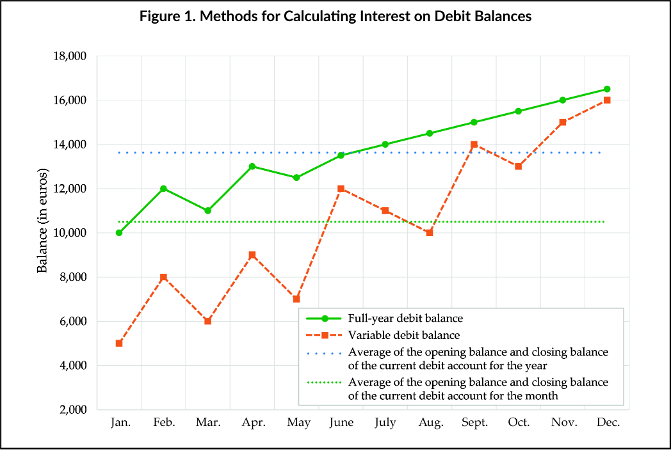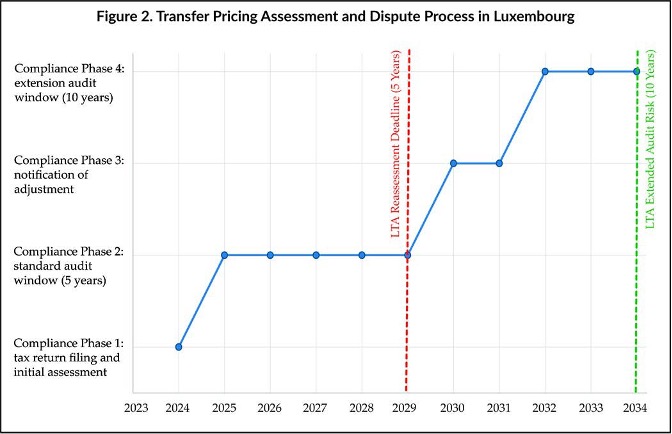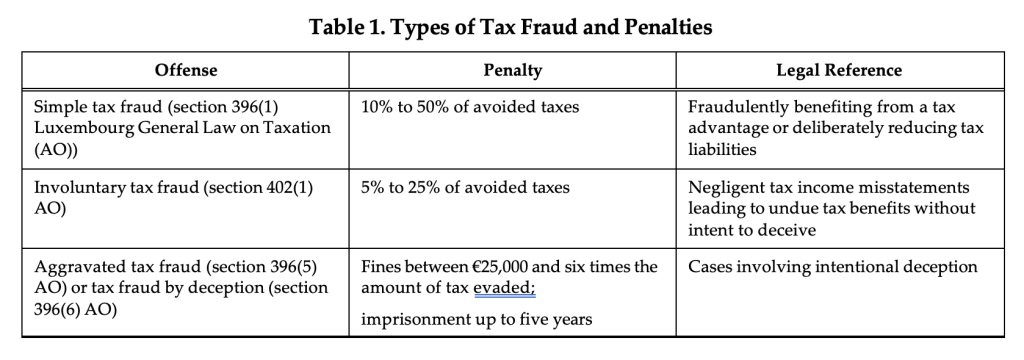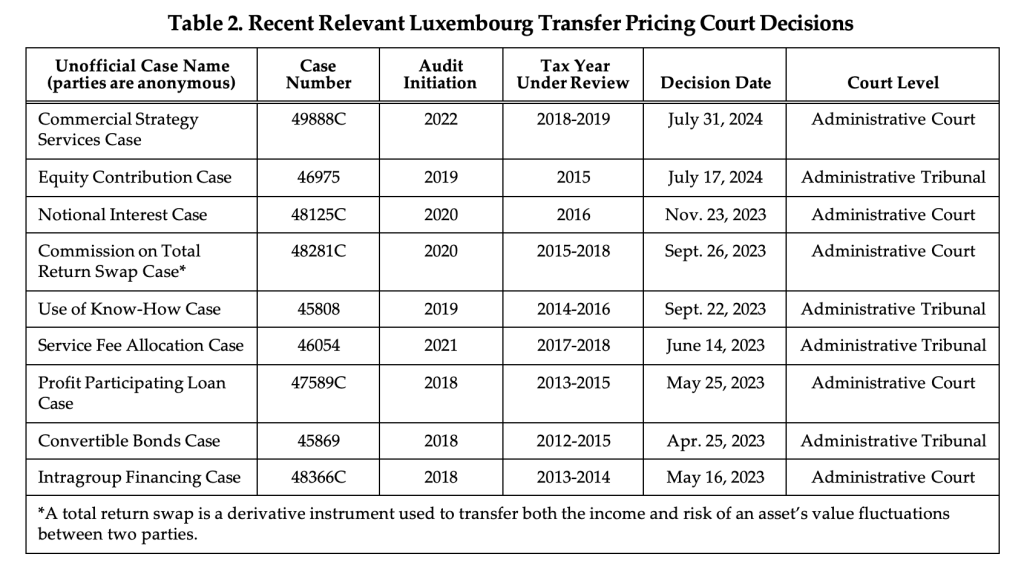On February 3 the Luxembourg tax authority (LTA) issued a new version of Circular L.I.R. No. 164/1, which addresses the determination of interest rates for debit current accounts held by shareholders or partners of entities subject to corporateincome tax.[1] The 2025 update introduces new benchmarks for market-based interest rates and reinforces the importance of maintaining robust transfer pricing documentation, particularly in relation to the treatment of shareholder and intragroup current accounts.
The revised circular is particularly relevant for companies with shareholder or partner debit current accounts, entities engaged in intragroup financing or treasury activities, and businesses subject to Luxembourg corporate income tax.[2] When the LTA identifies inconsistencies or inadequate documentation, companies may face administrative penalties, financialadjustments, or even legal consequences.
This article provides an analysis of the transfer pricing compliance process, new regulatory considerations for shareholder and intragroup accounts, the transfer pricing assessment and dispute process in Luxembourg, and an overview of recent transfer pricing court cases in Luxembourg.
Transfer Pricing Compliance in Luxembourg
Luxembourg’s transfer pricing framework is outlined in articles 56 and 56bis of the Luxembourg Income Tax Law, section 171 of the Luxembourg Tax Code, and Circular L.I.R. No. 56/1-56bis/1 (the transfer pricing circular). These rules establish that all transactions between a Luxembourg company and associated enterprises must adhere to arm’s-length market conditions, including those involving business restructurings.[3] To that end, a transfer pricing analysis must be prepared following the transfer pricing circular and the latest OECD transfer pricing guidelines.[4]
Unlike other jurisdictions, where transfer pricing documentation must be submitted with tax returns, in Luxembourg businesses are not required to submit documentation proactively but must maintain it and provide it upon request.[5] Furthermore, taxpayers must indicate in their annual corporate income tax returns whether they engage in intragroup transactions, regardless of their nature or amount. This disclosure obligation requires the attachment of an appendix demonstrating the application of the arm’s-length principle in intercompany transactions, ensuring compliance with section 171 of the tax code.
Many businesses assume that once their transfer pricing documentation is prepared and tax returns are filed, they have fulfilled their obligations. However, transfer pricing compliance is a continuous process. The LTA can reassess tax returns until the tax assessment is issued and until the statute of limitations expires, which is generally five years but may extend to 10 years in cases of nondeclaration or inaccurate reporting, regardless of whether there is fraudulent intent.[6]
“Unlike other jurisdictions, where transfer pricing documentation must be submitted with tax returns, in Luxembourg businesses are not required to submit documentation proactively but must maintain it and provide it upon request. Furthermore, taxpayers must indicate in their annual corporate income tax returns whether they engage in intragroup transactions, regardless of their nature or amount.”
New Regulatory Considerations
The 2025 version of Circular L.I.R. 164/1 provides specific guidance on how interest rates should be determined for debitcurrent accounts, distinguishing between cases in which the shareholder or partner is a natural person or a related enterprise.[7]
Shareholder or Partner Is a Natural Person
For individual shareholders or partners, interest rates must align with market rates, and companies may refer to the average consumer loan rates published by the Banque Centrale du Luxembourg.
Interest must be recorded at the end of the financial year and calculated following standard banking industry practices.
If the current account remains in a debit position throughout the entire financial year, the applicable interest charge shouldbe based on the arithmetic average of the opening and closing balances.
If the debit current account did not exist for the entire duration of the financial year or if there were significant variations in the balances, the arithmetic average of the debit balances at the end of the different months should be considered.
Figure 1 illustrates the methods for calculating the interest on debit balances.
Shareholder or Partner Is a Related Enterprise
For related enterprises, interest rates must be determined in compliance with the arm’s-length principle defined under articles 56 and 56bis of the Luxembourg Income Tax Law and reflected in article 164, paragraph 3 of the Luxembourg Income Tax Law, considering factors such as currency denomination, exchange rate risks, refinancing costs, and loan maturity.
It is important to point out that the 2025 circular explicitly states that only the provisions of service note L.I.R./N.S. No. 164/1 of June 9, 1993, relating to the criteria for a repayable debit current account, remain applicable.
For context, previous versions of the regulation were issued in 1998 and 1993. Both the 1998 version and the broader provisions of the 1993 version have been abolished. However, the specific provisions from the 1993 service note regarding the criteria for a repayable debit current account continue to apply.
To emphasize that debit current accounts must be structured as repayable loans, businesses must ensure that:
- a formal repayment obligation exists rather than an informal arrangement;
- failure to repay may lead to reclassification as a hidden profit distribution; and
- even if the loan is deemed legitimate, nonpayment of interest could still be taxed as a hidden distribution.
“The 2025 version of Circular L.I.R. 164/1 provides specific guidance on how interest rates should be determined for debitcurrent accounts, distinguishing between cases in which the shareholder or partner is a natural person or a related enterprise.”
Implications and Risks for Businesses
Businesses should assess the legal and economic substance of shareholder and intragroup debit current accounts by:
- ensuring that shareholder loans recorded as debit current accounts meet the criteria of repayable loans, as outlined in the 1993 version of the circular; and
- verifying that the debit current account represents an actual loan with a structured repayment schedule rather thanan indirect dividend or hidden profit distribution.
Businesses should verify the presence of a formal loan agreement. A repayable debit account should be supported by awritten loan agreement, which should include:
- a fixed repayment schedule;
- an agreed-upon interest rate based on market conditions; and
- the company’s expectation of full

If no agreement exists or repayment is not realistically expected, the debit current account risks being recharacterized as a hidden profit distribution.
Businesses should ensure that interest is accrued and paid in line with market rates. Interest must be determined in accordance with the specifications in this article’s sections “Shareholder or Partner Is a Natural Person” and “Shareholder orPartner Is a Related Enterprise.” Interest must be accrued properly to avoid the risk of tax adjustments. If interest is notregularly paid, the LTA may consider the unpaid interest as a hidden distribution of profits.
Businesses should monitor repayment activity to avoid reclassification risks by regularly reviewing debit current accounts to ensure that the repayment schedule is being followed. If repayment has been delayed or abandoned, the transaction may be retroactively reclassified as a distribution under article 164, paragraph 3, of the Luxembourg Income Tax Law.
Businesses should implement strong internal documentation to justify loan treatment by maintaining detailed records of:
- the original loan agreement;
- interest payments and adjustments; and
- any changes to the repayment
If the business is audited, these documents will help substantiate that the debit current account is a legitimate,repayable loan rather than a hidden profit distribution.
“Businesses should monitor repayment activity to avoid reclassification risks by regularly reviewing debit current accounts to ensure that the repayment schedule is being followed. If repayment has been delayed or abandoned, the transaction may be retroactively reclassified as a distribution under article 164, paragraph 3, of the Luxembourg Income Tax Law.”
Assessment and Dispute Processes
The transfer pricing assessment process in Luxembourg follows multiple phases, each carrying increasing financial and legal risks. Understanding the phases is crucial for businesses to mitigate tax exposure and penalties while ensuring compliance with transfer pricing rules.
Tax Return Filing and Initial Assessment
Luxembourg follows a declarative tax system, meaning that businesses must submit their tax returns, which include taxable income and supporting financial details, within the legally prescribed deadline.
The LTA issues an initial tax assessment automatically, based solely on the information provided by the taxpayer. This assessment is typically generated within 30 days of submission and determines corporate income tax, wealth tax, and municipal business tax liabilities.
However, this initial assessment is not final; the LTA retains the right to review and reassess tax returns within the applicable statute of limitations.
The Five-Year Standard Audit Window
The general statute of limitations in Luxembourg allows the LTA to reassess corporate tax returns within five years, [8] starting from January 1 of the year following the year in which the tax liability arose.
For example, if a 2024 tax return is filed, the LTA has until December 31, 2029, to initiate an audit and issue a revisedassessment. During this period, the LTA may:
- request clarifications on transfer pricing positions;
- demand intercompany agreements, financial statements, transfer pricing documentation, and other supporting materials to verify that transactions align with market conditions; and
- conduct on-site tax audits to perform a deep assessment of the functions, risks, and relevant documents, among others.
Notification of Adjustments
If the LTA intends to disagree with the submitted tax return, it must send the taxpayer a notification of adjustment before issuing a reassessment. Taxpayers are typically given two to three weeks to provide additional clarifications or supporting evidence before the final tax assessment is issued.
The 10-Year Extended Audit Window
If the LTA identifies the nondeclaration or inaccurate reporting of information, the standard five-year limitation period may extend to 10 years,[9] regardless of whether fraudulent intent is present. This means that for a 2024 tax return,the LTA could still conduct a reassessment until December 31, 2034. However, the extension applies only if new information comes to light that was not available during the standard period, such as undisclosed intercompany agreements, financial statements, or other relevant documents. In practice, this extension is rare because the emergence of genuinely new elements after the normal audit window is unlikely.
Figure 2 illustrates the transfer pricing assessment and dispute process in Luxembourg.
Documentation Requests and Penalties
Luxembourg does not require [10] taxpayers to proactively submit transfer pricing documentation; however, companiesmust be able to provide it immediately upon request by the LTA.
Failure to provide such documentation may result in an administrative penalty of up to
€25,000. If the documentation is deemed incomplete or inaccurate, additional penalties may apply, ranging from 5 percentto 25 percent of the avoided taxes. Taxpayers bear the burden of proof for justifying deductions and tax positions. However, once the LTA disputes a return, the burden shifts to the tax authority to justify an increase in tax liability.
Consequences of Noncompliance
If the LTA determines that a company misreported taxable income because of transfer pricing misalignment, it may [11] impose additional financial and legal penalties (see Table 1).


Appeals and Litigation Process
In the administrative phase a taxpayer may challenge an LTA assessment by filing an administrative appeal within three months of receiving the decision. The administrative appeal must be submitted by the end of the year following the tax event.
If the LTA fails to respond within six months, the taxpayer may escalate the case to the administrative tribunal — the litigation phase. The administrative court serves as the final appeal stage for tax disputes.
Filing an appeal does not suspend the payment of taxes due. Taxpayers must request a payment suspension separatelyand justify their reasoning to the LTA.
Assessment Cost
Noncompliance with transfer pricing regulations can lead to substantial financial and operational burdens, which tend toincrease over time and may become exponentially higher as disputes escalate. Each stage of the transfer pricing process has a cost:
- Preparation of transfer pricing documentation includes initial compliance costs, including benchmarking studies, documentation, and advisory fees (if necessary).
- Tax authority review (five years): Companies may incur additional accounting, tax, and legal fees to respond to LTA inquiries.
- Extension (additional five years): Extended reviews are the result from nondeclaration or inaccurate reporting of information, with decisions being made on a case-by-case basis, thereby increasing compliance costs.
- Request for information: Additional fees may be necessary for legal and tax advisory support in preparing
- Administrative penalties and adjustments: There may be direct financial penalties because of noncompliance or misalignment with the arm’s-length
- Legal dispute and appeals: If companies challenge a transfer pricing reassessment, litigation and legal fees escalate
- Resolution in court: Court proceedings can last several years, further increasing legal expenses and reputational risks.
Recent Court Cases
Analysis of recent transfer pricing court cases reveals several key trends, including prolonged litigation, limited financial disclosure, and an increase in the frequency that the LTA recharacterizes transactions. Table 2 lists the relevant cases.

Timing of Disputes
Tax audits generally start four to five years after the fiscal year under review. Litigation lasts between five and seven years, with some cases still unresolved after seven years.
Uncertain Financial Impact
Because of limited disclosure in legal rulings, the average transfer pricing reassessment cannot be accurately determined.Many cases refer to tax adjustments but do not specify precise amounts. Penalties, where mentioned, vary in nature, but exact percentages of avoided taxes remain unclear.
Tax Administration Approach
The outcome of LTA tax assessments has increasingly led to the recharacterization of transactions, with common reclassifications including:
- debt-to-equity conversions (for example, intragroup financing cases);
- royalties being reclassified as service fees (for example, intellectual property and know-how cases); and
- reallocations of expenses (which lead to adjustments in taxable income).
Conclusions
The 2025 version of Circular L.I.R. No. 164/1 represents a significant shift in Luxembourg’s transfer pricinglandscape, particularly regarding shareholder and intragroup current accounts. The updated guidance reinforces the importance of market-based interest rate determination and proper transfer pricing documentation, emphasizing compliance with articles of the Luxembourg Income Tax Law and OECD guidelines.
Companies must ensure that intragroup financing arrangements adhere to the arm’s- length principle and that shareholder debit current accounts are structured as repayable loans to avoid reclassification as hidden profit distributions.Failure to comply may result in tax reassessments, administrative penalties, and reputational risks.
Recent court rulings confirm the financial impact of transfer pricing misalignment, with prolonged litigation, increased scrutiny of financial structures, and more frequent transaction recharacterizations. Given these developments, businesses operating in Luxembourg must adopt a continuous compliance approach, ensuring that interest rates, repayment terms, and documentation align with regulatory expectations to mitigate risks and avoid disputes.
[1] LTA, Circular L.I.R. No. 164/1 (Feb. 3, 2025). It replaces the 1998 version of the circular.
[2] Luxembourg Income Tax Law, art. 164(3).
[3] Luxembourg Tax Code, section 171.
[4] OECD, “Transfer Pricing Guidelines for Multinational Enterprises and Tax Administrations” (2022).
[5] Luxembourg Tax Code, section 171.
[6] Luxembourg General Law on Taxation, section 144.
[7] LTA, 2025 circular, supra note 1.
[8] Id.
[9] Id.
[10] LTA, Circular L.G.-A No. 67 (July 28, 2021).
[11] Id.
This article was originally published in the March 10, 2025, issue of Tax Notes International.
Authors

Vanessa Ramos Ferrín
Managing Partner
TransFair Pricing Solutions
Search posts by topic
Advisory (6)
Alternative Investment (24)
Alternative investments (3)
AML (1)
Art (1)
Asset Management (26)
Banking (16)
Compliance (1)
Crypto-assets (3)
Digital Assets (3)
Digital banking (6)
Diversity (7)
EU (6)
Family Businesses (3)
Family Offices (2)
Fintech (10)
Fund distribution (22)
Governance (8)
HR (9)
ICT (1)
Independent Director (5)
Insurance (2)
Internationalization (1)
LATAM (9)
Legal (10)
Private Equity (4)
Regulation (1)
Reinsurance (2)
RRHH (9)
Sustainable Finance (23)
Tax (15)
Technology (6)
Transfer Pricing (2)
Trends (17)
Unit-linked life insurance (6)
Wealth Management (11)


